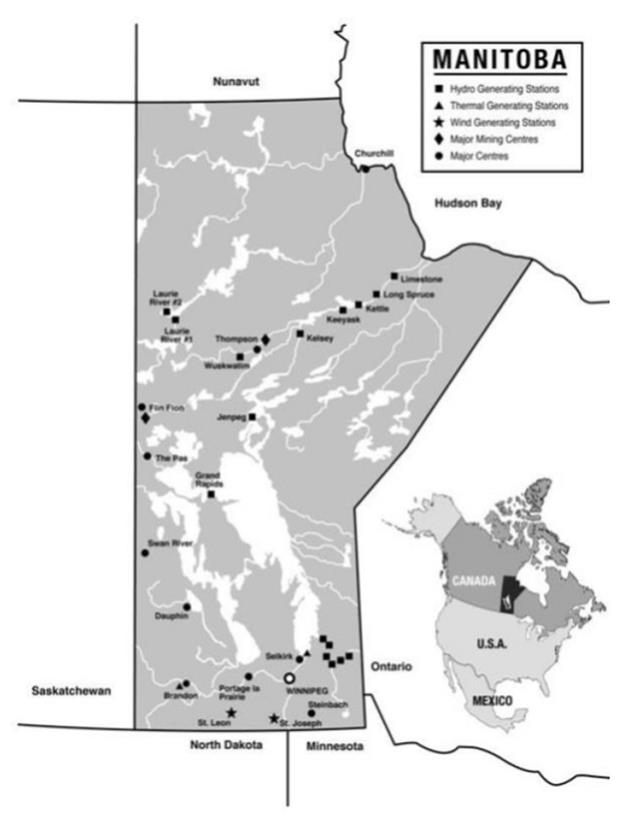THE PROVINCE OF MANITOBA
General Information
The Province of Manitoba is located in the centre of Canada, north of the States of Minnesota and North Dakota. It is the most easterly of the three Provinces of Manitoba, Saskatchewan and Alberta, which together constitute the Prairie Region of Canada. Manitoba is bounded on the east by the Province of Ontario, on the north by Hudson Bay and the Territory of Nunavut, and on the west by the Province of Saskatchewan. Manitoba has 400 miles of northern coastline bordering on Hudson Bay. The only seaport in the Prairie Region is located at Churchill on Hudson Bay.
Of Manitoba’s total area of 251,000 square miles, 39,000 square miles are lakes and rivers and 163,000 square miles are lands owned by Manitoba. Cultivated land comprises 28,000 square miles in the southern part of Manitoba. The northern part of the Province, which is part of the Canadian Shield, is composed largely of timberlands and extensive areas of mineralized rock structure.
The estimated population of Manitoba on July 1, 2020 was 1,379,263, an increase of 0.7% over the prior year. The Winnipeg Census Metropolitan Area had an estimated population of 857,300 in 2020, an increase of 1.5% over the prior year. Winnipeg, the capital of Manitoba, has a diversified economic base with significant activity in a variety of manufacturing and service sectors. Winnipeg is also a major air, rail and truck transportation hub by virtue of its geographical position in the centre of the continent.
The second-largest city in Manitoba is Brandon, with an estimated population of 52,983 on July 1, 2019, an increase of 1.3% over the prior year. Brandon, in western Manitoba, is a major supply centre for the agriculture industry, as well as an agriculture-related manufacturing centre.
Constitutional Framework
Canada consists of a federation of Provinces and Territories. A constitutional division of powers between the Federal and Provincial governments was established by the British North America Act, 1867, an Act of the Parliament of the United Kingdom. By later enactments, including the Constitution Act, 1982, the power to amend the constitution of Canada (the Constitution) was transferred to Canada.
Under the Constitution, the Provinces are assigned jurisdiction over education, municipal institutions, property and civil rights, natural resources and other matters of purely provincial or local concern. The Legislature of each Province has exclusive jurisdiction over the borrowing of money on the sole credit of that Province. The Parliament of Canada has jurisdiction over areas not assigned to the Provincial Legislatures, including such matters as aboriginal persons’ civil rights, the Federal public debt and property, the regulation of trade and commerce, currency and coinage, banks and banking, national defence, foreign affairs, postal services, interprovincial transportation and communications undertakings. The Provinces and the Parliament of Canada have shared jurisdictions over immigration, health care, environment and agriculture.
Various constitutional issues have been under discussion in Canada for a number of years. In 1998, in response to a reference from the Federal Government, the Supreme Court of Canada ruled that under the Constitution and international law, Quebec may not secede unilaterally from Canada, but that if the people of Quebec voted to secede by a clear majority vote on a clear question, the other Provinces and the Federal Government would be obliged to enter into negotiations with Quebec with respect to secession, such negotiations to be guided by constitutional principles, including federalism, democracy, constitutionalism, the rule of law and the protection of minorities.
Provincial Government
The Provincial Government has general responsibility for the administration of all governmental activities and functions within Manitoba, other than those which are under the jurisdiction of the Federal Government. It carries out certain of these responsibilities through Provincial agencies, boards, commissions and Crown organizations. Certain other responsibilities have been delegated to cities, municipalities and semi-autonomous bodies such as school boards and regional health authorities.
The executive power in the Province is vested in the Lieutenant Governor acting on the advice of the Executive Council, which is responsible to the Legislative Assembly. The Lieutenant Governor is appointed by the Governor General in Council on the advice of the Prime Minister of Canada.
The Executive Council, which includes the Premier and Ministers of Departments of the Provincial Government, is appointed by the Lieutenant Governor, usually on the nomination of the leader of the party with the largest number of members in the Legislative Assembly. Members of the Executive Council are usually members of the Legislative Assembly.
The Legislative Assembly has 57 members who are elected for a term of four years, subject to earlier dissolution of the Assembly by the Lieutenant Governor, usually on the recommendation of the Executive Council. In the last general election of members of the Legislative Assembly, held on September 10, 2019, the Progressive Conservative Party of Manitoba was elected with 36 of 57 seats. Unless it is called earlier, in accordance with The Elections Act (Manitoba) (the Elections Act), the next Provincial election is to take place October 3, 2023.
5

